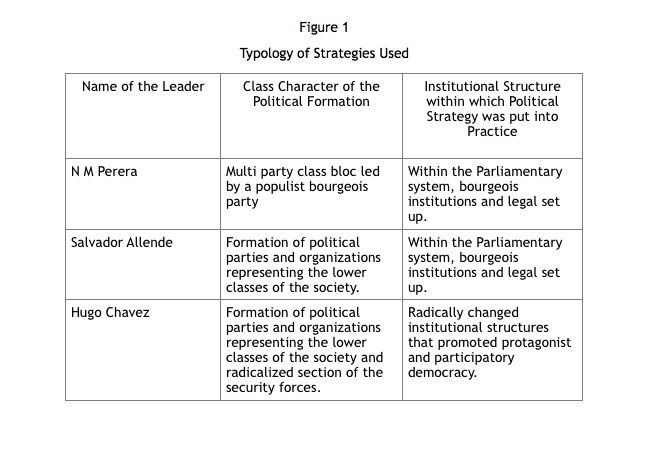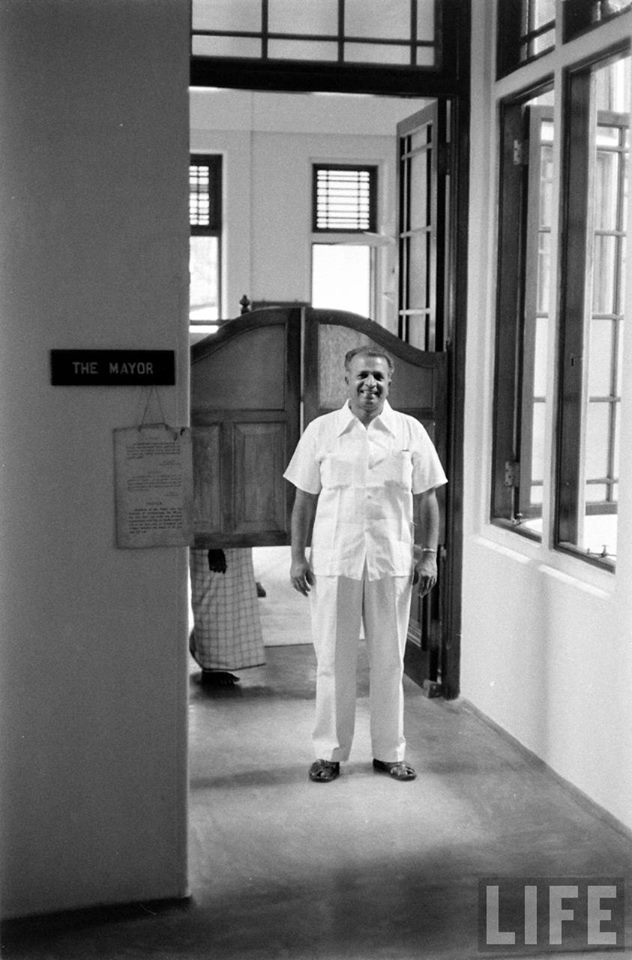N. M., Allende & Chavez: Re-reading Three Strategies For Socialism
By Sumanasiri Liyanage –
On the occasion of 110th birth anniversary of Dr. N. M. Perera, a leader of the Lanka Samasamaja Party (LSSP), commentators may praise him as a great democrat and outstanding parliamentarian. It has been generally agreed that N.M (as he was lovingly known) had contributed immensely for the development of parliamentary tradition in Sri Lanka. His critical analysis of the 1978 constitution foresaw the developments that had occurred in the last 37 years. When N.M wanted to replace it with new constitution, he did not just single out the executive presidential system as advanced in the 1978 constitution. People who has been focusing on only this aspect not only misunderstood his argument but also use his name as it was done in the discussion of the 19th amendment to inflate the validity of piecemeal amendments downgrading him just as a proponent of the Westminster tradition. N.M’s concern for democracy and the parliamentary tradition should be read not in isolation but linking them with his life-long effort and struggle to develop a system ensuring human emancipation and freedom. In this light, I propose to re-read N.M comparing him with another two great left leaders of the South, Salvador Allende of Chile and Hugo Chavez of Venezuela. Understanding their commonalities as well as differences would be helpful for young generation of Sri Lanka who are totally disoriented with the present system of exploitation, marginalization, and social exclusion propagated by neoliberalist globalization.
I may do an injustice to N. M. Perera and Salvador Allende since I propose to engage in this comparison from the perspective of what is called the 21st Century Socialism, the phrase widely used by Hugo Chavez, the youngest of the three. Nonetheless, from the futuristic point of view, I trust that 21st Century Socialism represents a better perspective. N.M. Perera and Salvador Allende operated in ‘late capitalist’ environment that in multiple ways differs from the current neoliberalist global environment. What are the critical features of the 21st century socialism? Chavez had identified three features: (1) economic transformation; (2) participative and protagonistic democracy in the political sphere; and (3) socialist ethics based on “love, solidarity, and equality between men and women, everybody”. Marta Harnecker has outlined what 21st century socialism should not entail in the following words: “we rejected any lack of democracy, totalitarianism, state capitalist methods, and bureaucratic central planning. We opposed collectivism that sought to standardize without respect for differences, and productivism that emphasized the expansion of productive forces without taking into consideration the need to preserve nature. We also wanted nothing to do with dogmatism, intolerance towards legitimate opposition, attempts to impose atheism by persecuting believers, and the belief that a sole party was needed to lead the process of transition.” In a more constructive sense, she identified five main characteristics of 21st Century socialism as advanced by Bolivarian revolutionaries:
- Human development as the center and focus. Socialism is to be governed by the logic of humanism and solidarity and have as its aim the satisfaction of human needs, not profit;
- Respect for nature, and opposition to consumerism. Our goal should not be to live “better” but to live “well”;
- Socialism requires a new dialectic of production/ distribution/ consumption based on: (a) social ownership of the means of production, (b) social production organized by workers and (3) the satisfaction of communal needs;
- A new concept of efficiency that both respects nature and seeks human development;
- Rational use of available natural and human resources through a decentralized participatory planning process that has nothing do with the hyper centralized bureaucratic planning of the Soviet state. (A World to Build. pp. 57 and 83-84)
This list signifies that 21st century socialism is qualitatively and significantly different from the socialism that existed in the Soviet Union and many other countries. Although somewhat critical on many issues, both N.M. and Allende had operated within this old framework that was characterized by more centralized bureaucratic planning and state ownership.
Three in Action
Although all three left leaders accepted social emancipation through socialism as their goal, they adopted significantly different strategies. It is also important to note that all three leaders decided to operate within the democratic structures rather than resorting to armed struggles. (See Figure 1)
 N.M and the LSSP in 1964 took a decision that was in total opposition to its previous political line. The decision was to enter into a coalition agreement with the populist bourgeois party, the Sri Lanka Freedom Party (SLFP) may be read as a novel experiment on the belief that if the support and the pressure of the left would make it possible to for the SLFP led government to go forward in the direction of socialism. N.M. himself had realized in the early 1970s that the experiment ended up in a failure and led the LSSP to come out of the coalition government. N.M.’s experiment has shown that peoples’ frontism with bourgeois parties would not bring in expected outcome even the parties of the working class work hard. Working class parties would be used to tame the struggles of the working class (ex: suppression of the bank strike) and as a necessary corollary, the working class party would get weakened as the lower classes get demoralized paving way for amore right wing repressive regime.
N.M and the LSSP in 1964 took a decision that was in total opposition to its previous political line. The decision was to enter into a coalition agreement with the populist bourgeois party, the Sri Lanka Freedom Party (SLFP) may be read as a novel experiment on the belief that if the support and the pressure of the left would make it possible to for the SLFP led government to go forward in the direction of socialism. N.M. himself had realized in the early 1970s that the experiment ended up in a failure and led the LSSP to come out of the coalition government. N.M.’s experiment has shown that peoples’ frontism with bourgeois parties would not bring in expected outcome even the parties of the working class work hard. Working class parties would be used to tame the struggles of the working class (ex: suppression of the bank strike) and as a necessary corollary, the working class party would get weakened as the lower classes get demoralized paving way for amore right wing repressive regime.
Salvador Allende led a political formation that represented the lower classes of society, workers, peasants and other marginalized layers of the Chilean society. Socialist Party and Communist Party were the main partners of the political front led by Allende. The left front government implemented many policies that brought in benefits to poor masses in the society. It appeared that Allende believed that he and his government could carry out its program using the same institutional structures. However, Fidel Castro, undisputed leader of Cuba, warned Allende and his government that the march towards social transformation would be impossible since the bourgeois will use existing institutions that include armed forces and police to hit back the progressive government. CIA together with Chilean armed forces planned a coup and killed Allende and toppled his government making room for Pinochet dictatorship.
Late Hugo Chavez, like Allende, began his term in office assuming that social transformation can be achieved within the existing system. He also called this strategy “Third Way”. However, he eventually realized that the Venezuelan oligarchy was not willing to accept any kind of reforms that affect their power and wealth. Hence when Chavez came up with limited reforms through new legislation, power oligarchy organized to a coup to overthrow Chavez. They started what Chilean bourgeoisie did under Allende by disrupting the economy. So it was in this context, Chavez made a statement marking a turning point in his term of office in 2004. He proposed to rescue socialism by re-reading the past experience. Chavez had come to conclusion the new version of socialism needs proactive participation of people and setting up novel institutions. Until his death, Chavez was able to reinvigorate movement for socialism in Latin America while its popularity was in decline in many part of the world.
Two lessons
Reviewing the three strategies of three left leaders in the South, we may easily arrive at two fundamental lessons. First is no social transformation and protagonist democracy can be achieved by aligning with the upper layers of the society. In Sri Lanka the extreme center now tend to think that either aligning with the SLFP or the UNP, first phase of the social change can be achieved. They have also argued that the change can be phased out by emphasizing democratic issues in the first phase and later thinking of struggle against neoliberalism later in the second or third phases. This is the old Stalinist stagist popular frontism. Chavez and Bolivarian movement has totally rejected this strategy by emphasizing the bloc of lower classes. The second lesson was although the first is a necessary condition it is not sufficient. In other words, the bloc of lower classes cannot and should not try to operate within the institutional set up created and maintained by the bourgeoisie. One of the key characteristic of the new institutional set up is decentralization of power and power-sharing.
For a SYRIZA like formation
We live in a new period, a period that characterizes the crisis of neoliberalism. The prescriptions of neoliberalism have proved in many countries that they lead to deflation of the economy and burden on poor masses. This is the situation in Sri Lanka. The failure of the so-called ‘change’ time and again emphasizes the need of social change. The lesson in Greece, the formation Syriza is one way for us to come out of the trap that we are in. In my view, in the next Parliamentary election, all the left parties should form and alliance with 21st socialism as its political strategy. Under given situation, I think that the JVP and FSP together should take the lead in forming such an alliance, ‘bloc of the lower classes’.
*The writer is the co-coordinator of the Marx School. e-mail: sumane_l@yahoo.com



Comments
Post a Comment